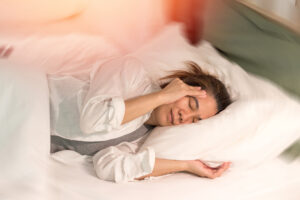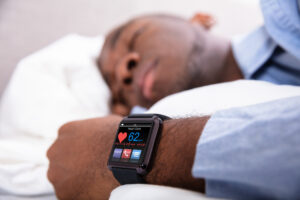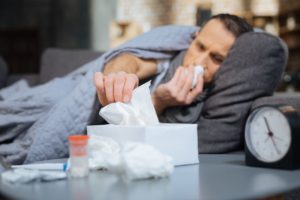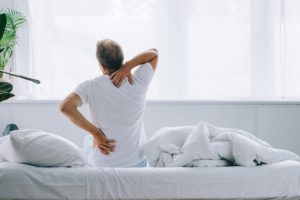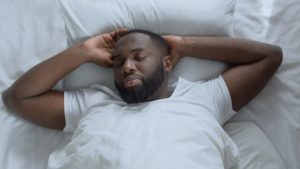When you buy through our links, we may earn a commission. Products or services may be offered by an affiliated entity. Learn more.
Nocturnal Seizures: Symptoms, Causes, Diagnosis, Treatment
Seizures happen when there is unusual electrical activity in the brain. Seizures that occur during sleep are called nocturnal seizures. Nocturnal seizures can disrupt sleep and cause poor sleep quality and excessive sleepiness. Occasionally, people can be injured or even die during nocturnal seizures.
Learning more about nocturnal seizures, including their symptoms, causes, treatment, and how to prevent injury during a seizure, can help people know what to do if they or a loved one experience a seizure event during sleep.
What Are Nocturnal Seizures?
Nocturnal seizures are seizures that happen during sleep . For some they may disrupt sleep, leading to fatigue, poor quality sleep, and daytime sleepiness. They may happen once in a lifetime, or multiple times as part of epilepsy. Epilepsy is a condition in which a person has two or more seizures, at least 24 hours apart, without a known cause.
Seizures and epilepsy are not uncommon. Up to 1 in 10 people will have at least one seizure in their lifetime. Over 2 million U.S. adults and nearly half a million children in the U.S. have epilepsy. About 10% to 15% of people with epilepsy have nocturnal seizures.
There are many kinds of seizures, with different causes, signs, and symptoms, though there are just several varieties of nocturnal or sleep-related seizures.
Sleep-related Hypermotor Epilepsy
Sleep-related hypermotor epilepsy (SHE) is the most common type of sleep epilepsy. SHE is sometimes called nocturnal frontal lobe epilepsy because the seizures from this condition usually start in the frontal lobe. They typically occur during nighttime sleep, but can happen during daytime naps as well. People who have SHE usually have several seizures a night.
People with SHE tend to have their first seizures when they are children or young teens. However, new cases of SHE have been found in babies as young as 1 year old and in adults in their sixties. Most people who have SHE will have seizures for the rest of their lives, but seizures may get milder and happen less often as they get older.
Benign Focal Epilepsies of Childhoods
Some young, healthy children have seizures during their sleep. There are three types of benign focal epilepsies.
- Benign epilepsy with centrotemporal spikes (BECTS): Sometimes referred to as rolandic epilepsy, BECTS account for 10% to 20% of childhood epilepsy cases. It is the most common type of seizure disorder in children. Almost 75% of seizures in children with BECTS occur during sleep or as a child awakens.
- Early-onset childhood occipital epilepsy: Seizures of early-onset childhood occipital epilepsy, also known as Panayiotopoulos syndrome, typically last more than five minutes with up to half of seizures lasting longer than 30 minutes. Evidence suggests that almost 50% of children with this type of epilepsy only experience a single seizure.
- Late-onset childhood occipital epilepsy: In late-onset childhood occipital epilepsy, or Gastaut syndrome, seizures are more frequent and shorter in duration. Most last less than 5 minutes. Many of these seizures happen during the day though they can occur during sleep as well.
The seizures of benign focal epilepsies usually begin in early childhood, but can happen in babies and teenagers. The outlook for children with benign focal epilepsies is generally favorable. Most children with these forms of epilepsy will stop having seizures before they become adults.
Other Sleep-related Seizures
Children and adults can also experience sleep-related seizures. Sleep-related seizures don’t happen during sleep but are often sleep-adjacent. For example, the seizures common in juvenile myoclonic epilepsy frequently happen as an adolescent awakens from sleep in the morning.
Evidence suggests that sleep can also accentuate seizures in people with certain medical conditions such as Lennox-Gastaut syndrome and Landau-Kleffner syndrome.
What Are Symptoms of Nocturnal Seizures?
Nocturnal seizure symptoms depend on which part of the brain is affected. Symptoms may range from brief awakenings from sleep to dramatic movements of the arms and legs or even sleepwalking or making noises. Some nocturnal seizures may not be recognized until a person has additional seizures.
Sleep-Related Hypermotor Epilepsy
Seizures of sleep-related hypermotor epilepsy are usually brief, lasting anywhere from just a few seconds to up to two minutes.
Nocturnal seizures from SHE usually stop and start very suddenly. They often involve stiffening of the muscles on one side of the body, with or without forceful, repeated movements of the arms, legs, trunk, and head. Some people may remember feeling scared or like they were falling, tingling, or shivering just before the seizures began.
Benign Focal Epilepsies of Childhood
The symptoms of seizures that develop with benign focal epilepsies may include:
- Face twitching
- Excessive drooling
- Arm movements
- Vomiting
- Sudden loss of muscle tone
- Staring
- Temporary blindness
- Temporary hallucinations
What Causes Nocturnal Seizures?
Seizures happen when nerves in the brain send fast and irregular electrical signals. The brain usually has an organized system of electrical signals that communicate with muscles and other nerves. However, when the brain’s electrical signals become disorganized, they can cause unusual muscle movements, sensations, or behaviors. The unusual electrical activity can also spread to other parts of the brain, leading to a more severe seizure.
Most nocturnal seizures happen during non-rapid eye movement (NREM) sleep. Disorganized brain signals happen more often during NREM sleep than they do during rapid eye movement (REM) sleep or while awake. Some seizures that start in one part of the brain may also be more likely to spread to other parts of the brain during NREM sleep than while people are awake.
Anything that injures the brain or affects brain signals also has the potential to cause a seizure. Potential causes of seizures include:
- Head injury
- Infection
- Brain inflammation
- Stroke
- Brain tumors
- Alcohol withdrawal
- Very low blood sugar
Sometimes doctors can’t explain why a person develops a nocturnal seizure, though there is often a family history of nocturnal seizures in such cases.
How Are Nocturnal Seizures Diagnosed?
Doctors will often perform several tests to diagnose nocturnal seizures. Multiple conditions can cause nocturnal seizures. In addition, symptoms of nocturnal seizures can be similar to those of sleepwalking, night terrors, and other parasomnias. Because different conditions may have different treatments, it is important to diagnose the cause of nocturnal seizures.
History and Physical Examination
A doctor taking care of someone who had a seizure will usually ask detailed questions about the seizure. A person who had a seizure may not be able to remember much of what happened during their seizure, so if anyone else saw the seizure then it can be very helpful to have them describe it to the doctor. A doctor will usually ask about:
- Any possible triggers or unusual feelings just before the seizure started
- How the seizure started
- What parts of the body were involved in the seizure
- What happened during the seizure, including movements, noises, and changes in awareness
- How long the seizure lasted
- How long it took for the person to return to normal after the seizure ended
- Any illnesses, injuries, or medications that may have caused the seizure
- Whether any family members have epilepsy
The doctor will do a full physical examination to look for signs of injuries from the seizure, and for conditions that could have caused a seizure. They will also do a detailed neurologic examination to check for any disorders or injuries to the nervous system.
Electroencephalography
Electroencephalography (EEG) is an important tool to diagnose seizures. An EEG is a painless recording of brain waves. It can be performed in a hospital, at a doctor’s office, or sometimes even in a person’s home.
A specially-trained healthcare provider will stick several flat metal electrodes all around a person’s head. The electrodes should not be painful, but they may be sticky. The electrodes are connected by long wires to a machine that records electrical activity in the brain. A person may be asked to stay still and quiet during an EEG or they may be asked to look at flashing lights or other possible triggers. Some EEGs may be recorded on video to help with diagnosis.
Many people with nocturnal seizures have normal brain electrical activity while they are awake. For this reason, some doctors may recommend an overnight EEG combined with a sleep study to diagnose nocturnal seizures. In other cases, they may recommend that an EEG be done over several days in a person’s home or in the hospital.
Brain Imaging
The first time that a person has a seizure, a doctor may recommend a brain MRI to check for bleeding, a stroke, tumor, or another possible seizure cause. However, some doctors may not recommend brain scans for some children if they can determine the cause of the seizure from the history, physical examination, and EEG.
Additional Tests
Depending on what conditions the doctor suspects, they may order additional tests such as blood tests, a heart scan, or a lumbar puncture. These tests may not be needed for all people who have nocturnal seizures.
What Are Treatment Options for Nocturnal Seizures?
Most people who have nocturnal seizures are treated with anti-seizure medications. Some who continue to have seizures despite trying two or more medications may be recommended for epilepsy surgery or electrical stimulation of the brain or the vagus nerve. Doctors may also recommend healthy lifestyle choices, such as practicing healthy sleep hygiene and avoiding or reducing alcohol and illicit drug use.
Doctors consider several factors when they select a treatment for seizures.
- Number of seizures: Doctors usually won’t prescribe anti-seizure medications for people who have only had one seizure.
- Cause of the seizure: If a seizure was caused by another medical condition, such as a stroke, an infection, or low blood sugar, then a doctor will usually treat the underlying condition rather than start anti-seizure medications. The risk of additional seizures is lower if a seizure was caused by a treatable condition than if there was no known cause.
- Likelihood of future seizures: A doctor may recommend anti-seizure medications after the first seizure if they believe the individual has a high risk of having more seizures in the future. Doctors consider the individual’s other medical conditions, results of brain scans and EEGs, and whether the individual has a family history of epilepsy.
- Frequency and severity of seizures: People with more frequent or more severe seizures may need one or more than one medication to keep their seizures under control. Some children with only mild and infrequent nocturnal seizures may not need anti-seizure medications.
- Response to treatment: Most people with seizures will respond well to one anti-seizure medication. However, if people keep having seizures after starting an anti-seizure medication, then their doctors may switch them to a different medication or add a second medication.
Prompt treatment of nocturnal seizures can reduce the risk of having additional seizures, of having more severe seizures in the future, and of injury or death from a seizure. There is evidence that seizures can become more difficult to control if treatment is delayed or not followed. People with epilepsy who do not take their medications as recommended are at higher risk of sudden unexpected death in epilepsy (SUDEP).
Sleep Safety Practices if You Have Nocturnal Seizures
People who have nocturnal seizures are at risk of injury or death due to SUDEP. People who have nocturnal seizures and their loved ones can take steps to lower their risks.
- Supervision during sleep: People who are not watched while they recover from a seizure are at higher risk of SUDEP. One large study found that people with epilepsy who were watched or checked on while they slept had a lower risk of SUDEP than those who slept alone.
- Move the mattress to the floor: People can be injured by falling out of bed during a nocturnal seizure.
- Move heavy furniture away from the bed: People who move their arms or legs during seizures could be injured if heavy furniture is knocked onto them during a seizure.
- Consider side or back sleeping: Some studies have found a higher-than-expected rate of stomach sleeping among people who died of SUDEP. While the exact risks of stomach sleeping during nocturnal seizures aren’t fully understood, some experts believe that it may cause choking or blocked airways.
Parents, caregivers, and loved ones of people with nocturnal seizures should know what to do if a seizure happens:
- Roll the person on their side to prevent choking on saliva or vomit
- Time the seizure and call 911 if it lasts for more than five minutes
- Do not put anything in their mouth-it could break their teeth or they could accidentally bite the person trying to help them
- Loosen or remove anything around their neck
- Protect them from rolling off the bed or from anything that could hurt them
- Stay with them until they have recovered and are no longer confused
When to Talk to a Doctor
A person should see a doctor as soon as possible after they have a seizure for the first time. They should also tell a doctor if they have a second seizure, as this may mean they have epilepsy. People with epilepsy should also notify their doctor if their seizures start to happen more often, become more severe, or otherwise seem different from usual for them.
If someone sees another person having a seizure, they should call 911 if:
- The seizure lasts more than five minutes
- Another seizure starts before the person wakes up
- The person does not wake up or breathe normally after the seizure ends
- Someone is injured during the seizure
- The seizure happens in water
- The person having the seizure is pregnant or has diabetes

Still have questions? Ask our community!
Join our Sleep Care Community — a trusted hub of sleep health professionals, product specialists, and people just like you. Whether you need expert sleep advice for your insomnia or you’re searching for the perfect mattress, we’ve got you covered. Get personalized guidance from the experts who know sleep best.
References
7 Sources
-
St. Louis, E. K., & Foldvary-Schaefer, N. (2021, May 25). Sleep-related epilepsy syndromes. In A. Y. Avidan & P. Garcia (Eds.). UpToDate.
https://www.uptodate.com/contents/sleep-related-epilepsy-syndromes -
Benbadis, S. R. (2021, December 2). Benign (self-limited) focal epilepsies of childhood. In D. R. Nordli (Ed.). UpToDate.
https://www.uptodate.com/contents/benign-self-limited-focal-epilepsies-of-childhood -
Rosengard, J. L, Ferastraoaru, V., & Haut, S. (2018, September 25). Frontal lobe epilepsy. Medscape.
https://emedicine.medscape.com/article/1184076-overview#showall -
MedlinePlus: National Library of Medicine (US). (2009, April 1). Autosomal dominant nocturnal frontal lobe epilepsy.
https://medlineplus.gov/genetics/condition/autosomal-dominant-nocturnal-frontal-lobe-epilepsy/ -
National Institute of Neurological Disorders and Stroke. (2023, January 20). Epilepsy and seizures.
https://www.ninds.nih.gov/health-information/disorders/epilepsy-and-seizures -
Adamolekun, B. (2022, March). Seizure disorders. Merck Manual Consumer Version., Retrieved January 30, 2023, from
https://www.merckmanuals.com/home/brain,-spinal-cord,-and-nerve-disorders/seizure-disorders/seizure-disorders -
Schachter, S. C. (2022, October 26). Evaluation and management of the first seizure in adults. In P. Garcia & J. A. Edlow (Eds.). UpToDate.
https://www.uptodate.com/contents/evaluation-and-management-of-the-first-seizure-in-adults





